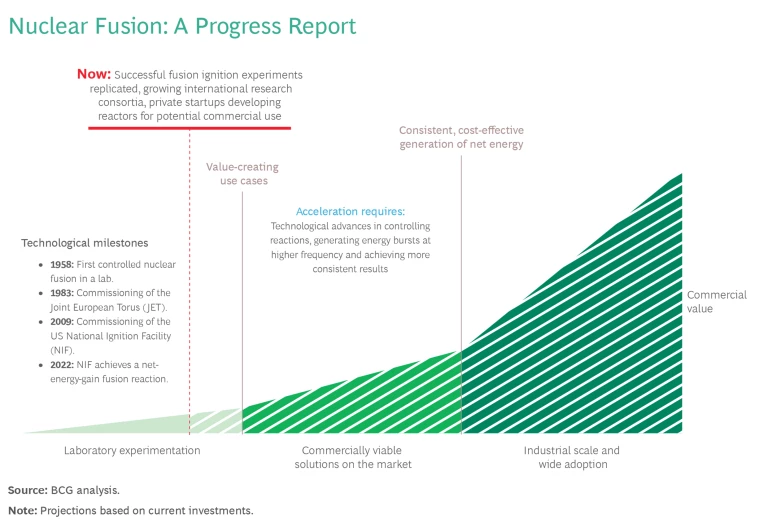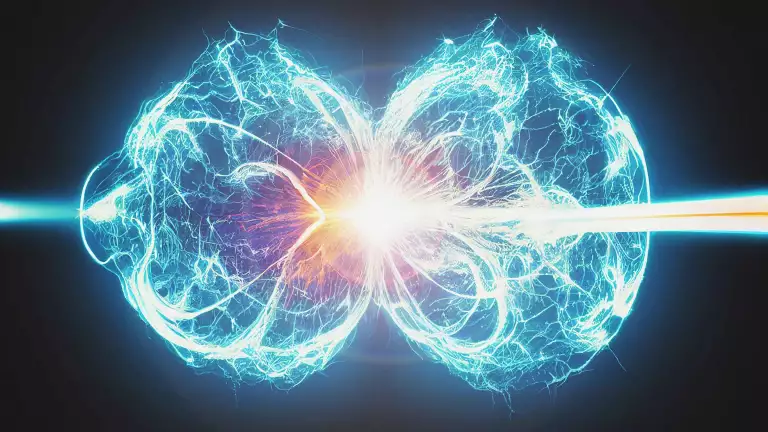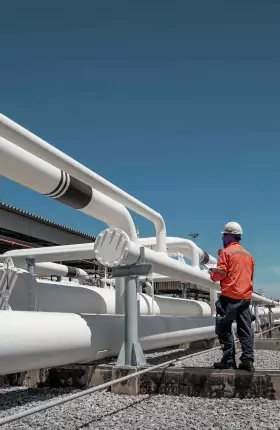For a very long time now, nuclear fusion has been looked upon as the energy frontier. By harnessing the same process that powers the sun and the stars, we can have limitless, cheap, and broadly accessible power. No radioactive waste, no climate-damaging emissions, no risk of reactors erupting out of control. Indeed, fusion reactors should be safe enough to locate in densely populated areas.
Yet commercially viable fusion, which releases tremendous energy by combining light atomic nuclei, has seemed to remain stuck in the realm of wishful thinking. It’s supposed to be 20 years away. But it’s been like that for over 50 years. Hyped claims over the years haven’t helped.
A number of signs, however, suggest that fusion development is accelerating rapidly—and that reactors could conceivably begin feeding power into national grids in the foreseeable future. It’s time that fusion command the C-suite’s attention. Depending on your risk appetite, it may even be time to directly engage.
Yes, grounds for skepticism abound. But a strong case can also be made that a confluence of developments over the past few years has brought fusion energy much closer to reality. There have been important breakthroughs, both in the science and in specific technologies needed for practical fusion reactors. Almost $5 billion has been invested by private (or semi-private) investors in fusion over the past five years, and the intensifying push for decarbonization is prompting governments around the world to invest billions more in international research consortia and prototype reactors. At the recent COP28 climate conference, 20 countries pledged to triple nuclear energy capacity by 2050, and fusion could account for a significant share. More passionate young PhD and college graduates have recently entered this space.

Perhaps most important, there is growing market interest in fusion. More startups are taking fusion technologies out of the national labs and into the private sector, with detailed, ambitious plans to get reactors into commercial production. And they’re backed by serious investors who believe fusion energy will be required to address our climate and energy crises—and expect to see some sort of return.
Impressive Technological Progress
The scientific principles behind fusion have been known for many decades. But in the past few years, there have been tangible signs that we’re approaching a breakthrough moment—the point where fusion reactors consistently generate more energy than they consume. The biggest development came in December 2022, when physicists at the National Ignition Facility (NIF) at Lawrence Livermore National Laboratory achieved “fusion ignition,” generating more energy from a controlled reaction than they had used to trigger it. Since then, several other labs have independently confirmed that result.
So we know the physics works. The big question is whether the physics can work to economically generate industrial levels of power. The key challenges: better controlling reactions, producing energy bursts at a higher frequency, and achieving greater consistency. Among other challenges, researchers have been getting very different energy outputs as they tweak their experiments.
Whether all these issues can be resolved is still to be determined. But this is all part of scientific progress. The NIF and other research institutions are pinpointing the questions that must be addressed regarding the exact conditions and critical elements of fusion reactions. This will help bring much more clarity. There have also been important breakthroughs in technologies that are important to fusion projects, such as lasers and powerful, superconducting magnets.
There have also been important breakthroughs in technologies that are important to fusion projects, such as lasers and powerful, superconducting magnets.
Startups Are Accelerating the Pace
Until very recently, public attention has focused mainly on massive, multibillion-dollar international research projects like the International Thermonuclear Experimental Reactor (ITER) in southern France, which is supported by 35 countries. Others are based or under construction in the UK, France, Germany, Spain, Russia, India, China, South Korea, and Japan. Such facilities, which are intended for experiments that solve technical problems, take 10 to 20 years just to plan and build.
Now, we’re seeing companies run by people who believe they can make things happen with more moderate capital—several hundred million dollars, say, rather than the $20 billion or more of a program like ITER. These startups are small in comparison. But some are well-funded and are making faster progress. Some are building demonstration reactors that could be producing tens of megawatts of fusion power within the next three to five years—or at least that’s the ambition. And they’re getting support from leading tech investors, sovereign funds, and various industrial players.
Fusion startups, like government-funded projects, are pursuing basically two types of design: magnetic confinement and inertial confinement. The most common design for a magnetic confinement reactor is called a tokamak, a concept introduced in Russia in the 1950s. It involves holding superheated, electrically charged plasma in a pressurized doughnut-shaped or cylindrical container. Extremely powerful magnetic fields push hydrogen nuclei together until they collide and release energy.
Commonwealth Fusion Systems, an MIT spinoff that has raised around $2 billion from investors that include Bill Gates’s Breakthrough Energy Ventures, Singapore’s Temasek, and Norwegian energy company Equinor, has broken ground on a midsize tokamak reactor that it hopes will generate 50 to 140 megawatts of power by 2025. Tokamak Energy, based near Oxford, claims to have built a compact, spherical tokamak that is the “smallest and most cost-effective solution for fusion energy.” Another startup, Canada’s General Fusion, is building a demonstration tokamak that it hopes will be generating commercial power in around a decade.
The other main technology, inertial confinement, uses intense laser pulses to hit hydrogen pellets and create fusion energy. The plasma inside the reactor is held in place by its own inertia, rather than by magnets. This is the approach the NIF has successfully demonstrated. To generate steady, industrial-scale energy, you need to replicate those laser pulses at a very high frequency and continually replace the pellets. German startup Marvel Fusion is collaborating with Colorado State University to build an inertial fusion research reactor that is targeted for completion in 2026.
Yet another interesting startup, Helion Energy, has six prototypes using a technology that combines magnetic and inertial confinement. It has announced a collaboration with US steelmaker Nucor to develop a 500 MW reactor that it hopes to commission by the end of this decade.
At this stage, it’s too early to say which of these mousetraps is best—or whether any will achieve their goals within their ambitious timeframes. But companies should keep an eye on this space and the technologies competing to lead this industry. If any can prove that fusion is economically viable, that would be phenomenal. The next three to five years should be very exciting, indeed.






